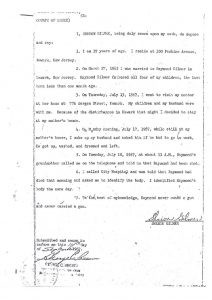Raymond Gilmer

Raymond Gilmer grew up in Newark’s East Ward at the corner of Ferry Street and Manufacture Place, where he and his nine siblings were raised by their grandmother, Mrs. Bessie Hopkins. After leaving school in tenth grade to start working, Gilmer later married his wife Sharon, with whom he had four children, the last being born after his death. The Gilmer family lived in a small apartment at 300 Peshine Avenue.
On Thursday, July 13th, the Gilmers went to visit Sharon’s mother at her Bergen Street apartment. The previous night, police had clashed with protestors outside the Fourth Precinct after taxi driver John Smith was arrested and beaten there. As the violent conflict entered its second night on Thursday, and with Sharon eight months pregnant, the Gilmer family decided to stay at her mother’s apartment to avoid being out on the streets, and they stayed until Monday when the rebellion had subsided.
On Monday morning, July 17th, Raymond left the apartment, either for work or to look for a bigger apartment for his family, and was unaccounted for until he returned to Bergen Street around midnight.
Around 12:30 A.M., Lance Corporal John Richardson was standing in Arlene’s Luncheonette on Clinton Avenue when he saw a black Pontiac turn the corner of Clinton and Jeliff Avenues and stop about 30 yards from the corner. “In pursuit of the Pontiac there was one patrol car which came off Clinton into Jeliff Avenue,” Richardson recalled. “During the time that the patrol car was on Clinton Avenue the sirens had not been sounded. They were only sounded after the patrol car entered onto Jeliff Avenue.”
After stopping the car, the driver of the Pontiac, Raymond Gilmer, got out of the car and started running towards an alley about 15-20 yards away.
“Without any warning, a shot was fired from the patrol car,” Richardson said. “The man was hit and fell, but he did not die right away. The man could be seen breathing heavily after being shot.”
A Newark detective shot Raymond Gilmer in the back of the head. As he fell, officers in the patrol car shot at him a second and third time.
“There were about three or four patrolmen in the patrol car,” Richardson told Newark Legal Services Project. “All the patrolmen exited from their car, and one walked over to the man who had been shot. He shined a flashlight on the wounded man and began to go through his pockets. No weapons were discovered, only a wallet.”
“There were cops all around the man and he had no weapon,” witness Herbie Bell said. “They searched the body and the car and didn’t find anything.”

After searching the black Pontiac, “all the patrolmen went back to the body and merely looked at the man who was still breathing heavily,” John Richardson said. “No effort was made to call an ambulance.” Richardson then took it upon himself to call an ambulance for Raymond Gilmer, who was pronounced dead at City Hospital.
Despite the accounts of three eye-witnesses who watched Newark policemen search the body and car of Raymond Gilmer and find nothing, the police reports and Grand Jury presentment claimed that police found a .38 caliber revolver under the driver seat and a knife near Gilmer’s body. The Grand Jury also claimed that Gilmer had fired a shot at the pursuing police car—a detail that is absent from all known witness accounts. According to his wife Sharon, “Raymond never owned a gun and never carried a gun.”
Raymond Gilmer was dead at the age of 20 after having been shot in the back of the head by a Newark police detective. Sharon Gilmer found out about her husband’s death the next day and identified his body at the City Hospital. She delivered her and Raymond’s fourth child a month later.
The Essex County Grand Jury found “no cause for indictment” of the officers involved.
References:
Ronald Porambo, No Cause for Indictment: An Autopsy of Newark
Witness Testimony of John Richardson and Sharon Gilmer before the Essex County Grand Jury
Notes of Newark Legal Services Project on Interviews with Herbie Bell, Ray McKinon, and John Richardson
Presentment of the Eighth Essex County Grand Jury of 1967

Newark Legal Services Project draft deposition of John Richardson on the fatal shooting of Raymond Gilmer on July 18, 1967. — Credit: Junius Williams Collection

Witness statement given to Newark Legal Services Project by Herbie Bell on the fatal shooting of Raymond Gilmer on July 18, 1967. — Credit: Junius Williams Collection

Witness statement given to Newark Legal Services Project by Ray McKinnon on the fatal shooting of Raymond Gilmer on July 18, 1967. — Credit: Junius Williams Collection
Explore The Archives

Grand Jury report describing the death of Raymond Gilmer on July 18, 1967, who was “fatally shot in the back of the head” by a Newark detective “after disregarding an order to halt.” The Grand Jury found “no cause for indictment.” — Credit: Newark Public Library

Witness statement given to Newark Legal Services Project by John Richardson on the fatal shooting of Raymond Gilmer on July 18, 1967. — Credit: Junius Williams Collection

Deposition of 19-year-old John Richardson before the Essex County Grand Jury, in which he describes the fatal shooting of Raymond Gilmer on July 18, 1967, who he claims was shot by Newark Police “without any warning.” — Credit: Newark Public Library
